These Are Some Of The Best Things To Do In Budapest, Hungary!
It’s not really a secret that there are loads of things to do in Budapest, the Hungarian capital city. In fact, there may be TOO many things to do!
That said, there are lots of different things to do in Budapest regardless of the month you are visiting in – from the summer heat of July to the December winter wanders!
If you’re travelling to Europe for the first time, consider Budapest as a stop on your Europe itinerary.
We’ve been to Budapest multiple times now and Eric is half Hungarian, so it’s a city that holds a special place in our hearts. Having wandered lots of Eastern Europe, it’s a fun city with something for everyone!
But what are the best things to do? Like the things that you just cannot miss? We decided to write them down!
So, whether you’re looking for crazy things, unique things, or just things to do during the day or night in any season, this list has got you covered!
Table of Contents
Great Things To Do In Budapest, Hungary
Okay, let’s dive into some of the best things to do in Budapest.
These are in no particular order and jump across the city so have a read through to decide on what you want to see and do!
Visit the Buda Castle Complex on Buda Hill
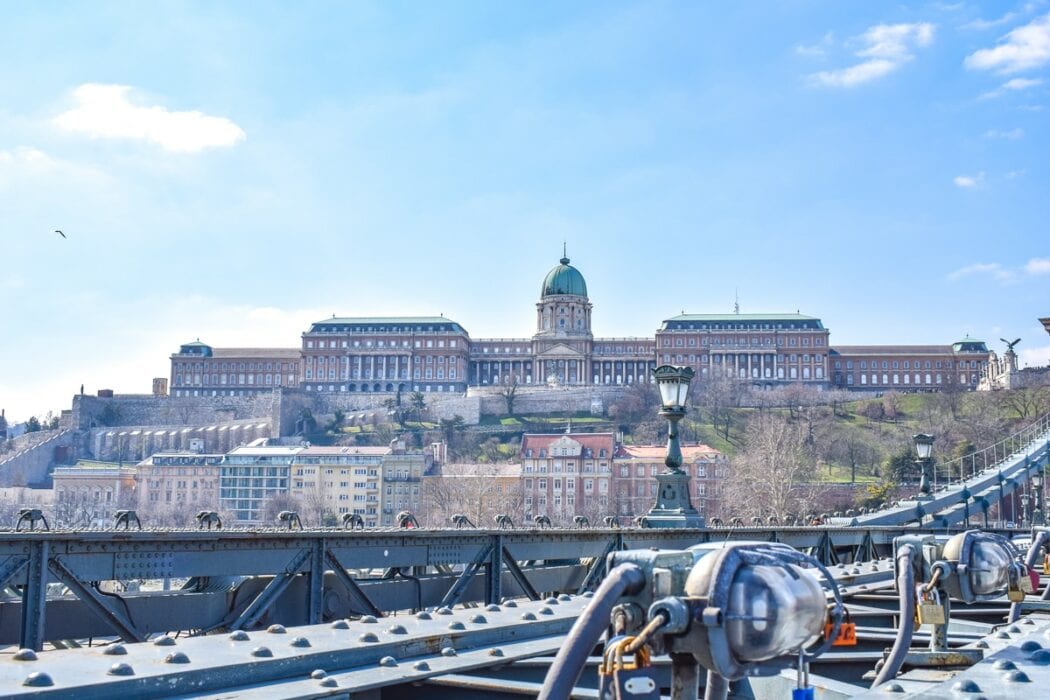
Dating back to 1265, the Buda Castle complex cannot be missed when you’re in Budapest. No, literally – you can’t miss it since the iconic dome of the Royal Palace atop Buda hill can be seen from many places in the city!
The Castle used to house the Kings right up until 1918. Today, you can visit the castle grounds for free, but there are many museums, galleries, and other exhibits that you can buy tickets for once you’re up there.
To get up there, you can take one of the many walking paths, a shuttle bus, or the famous funicular cable car that glides passengers right up to the castle grounds.
A funicular ticket can be expensive – but worth it for the iconic experience.
Address: Budapest, Szent György tér 2, 1014 Hungary
Ride the Budapest Funicular
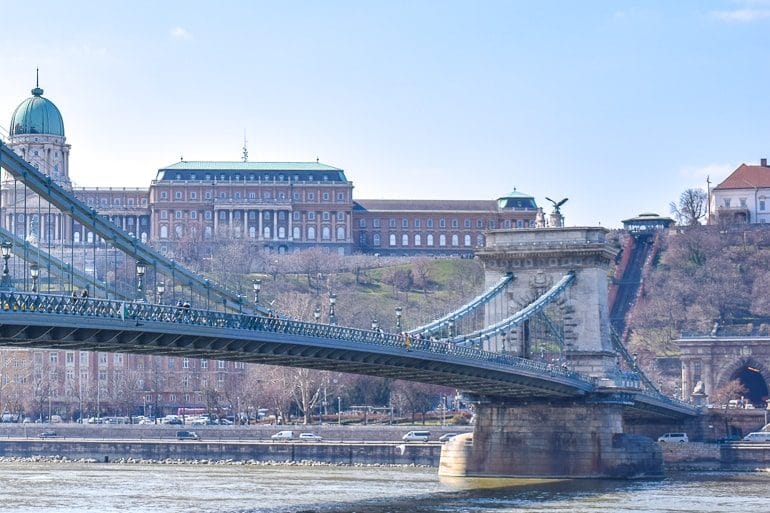
Speaking of riding the funicular to get up to see the Castle, many would consider this a thing to do. In all honesty, it’s just another way to get to the Castle complex, but it’s a necessary one for people with mobility issues.
First opened in 1870, the funicular is both practical and a bit of a tourist attraction. The short ride makes for great photos and a nice little video!
That said, the lineup at the bottom to get on can be pretty long. You can read more about hours of operation and prices here.
Address: Budapest, Clark Ádám tér, 1013 Hungary
Walk Váci Street
Close by to the Eye, you’ll find the start of Váci Street – the famous pedestrian mall that runs the length of the Inner city.
Lined with numerous shops, stalls, and seasonal pop-ups for Easter and Christmas, it’s a great stroll if you want to feel like you’re in all the action.
Some might consider it “touristy” but like any other pedestrian mall, you’ll find a mix of locals and visitors going about their business!
The Budapest Eye
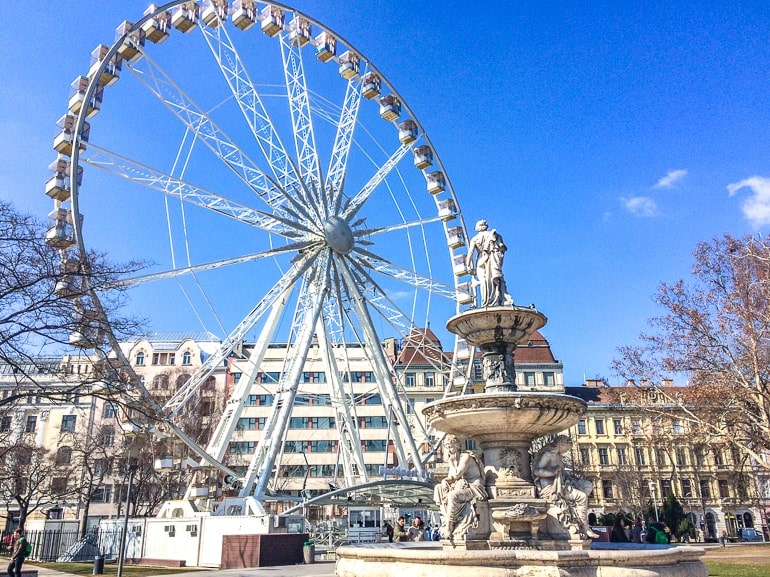
If you’re wandering the Inner City in Pest, there’s a good chance you’ll stumble upon the Budapest Eye in Erzsébet Square.
For 3 turns of the 65-metre tall eye, it’s 9 euro for adults and 5 euro for children. Worth the views when the city is all lit up at night! You can learn more at the official website here.
Location: Erzsébet Square
Enjoy the Thermal Baths
Budapest is known for its thermal baths that are scattered around the city. If you didn’t know that – well, now you do.
It’s a great city for engaging in the tradition of going for a dip to relax, de-stress, and unwind.
Since there are so many around the city – with some being more famous and busier than others – here’s a brief breakdown of the main ones that you can visit:
Széchenyi Medicinal Baths
Many would consider Széchenyi the “main” thermal bath in Budapest.
This massive complex of indoor and outdoor pools was built in 1913 and holds the title of the largest thermal bath in Europe.
If you know that you want to take a dip at Széchenyi when you visit, consider buying your entrance ticket beforehand to skip the line.
Address: Budapest, Állatkerti krt. 9-11, 1146 Hungary
Rudas Baths
First built in 1550 during the Ottoman rule in Budapest, the beautiful baths have gotten a few additions and upgrades like a rooftop pool and saunas in recent years. Have a look at Rudas Baths here.
Address: Budapest, Döbrentei tér 9, 1013 Hungary
Gellért Baths
The famous Art Nouveau baths were built in 1918 and overlook the Danube from Buda.
Connected to the hotel complex by the same name, Gellért has been letting visitors soak in the rich medicinal waters for a century.
We’ll mention this below, but staying at the Gellért Hotel allows you free admission to the baths.
If you’re confident Gellért is for you, grab a full day ticket beforehand for Gellért and secure a locker or changing cabin.
Address: Budapest, Kelenhegyi út 4, 1118 Hungary
Take a Boat Cruise on the Danube
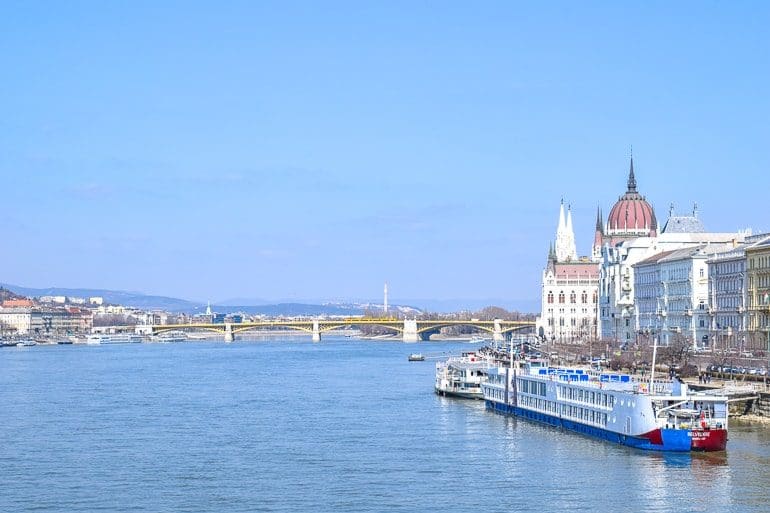
The River Danube continues to play a huge role in shaping Central and Eastern Europe. So, it’s only fitting that you see Budapest from the water!
A river cruise is a great way to do this. Eric actually did a night cruise back in 2015 and even though it was raining a bit – discovering Budapest from the water was a very cool experience.
There are lots of different companies that leave from along the river’s edge close to the Chain Bridge so you can just show up and book something or you can book in advance.
Here’s a ticket for a night cruise with a drink included! This one is very similar to the one Eric did.
Visit the Ruin Bars
If you are coming to Budapest, you might be interested in seeing the famous “ruin” bars.
They are exactly what they sound like – bars in old, falling apart buildings or outdoor spaces.
Kert means “garden” in Hungarian – and that makes a whole lot of sense when you enter a few of them!
There are a whole bunch of bars to choose from in Budapest’s lively 7th District – Erzsébetváros. The former Jewish Quarter is home to some fascinating history, architecture, and – these days – the best nightlife in the city.
We’ve been to a few ruin bars and really liked Mika Kert and Ellato Kert & Taqueria – both outside in garden areas with loads of seating. Both were very full when we arrived for evening drinks!
The other ruin bar you will likely have heard of is Szimpla. It’s huge, popular, and the line up to get in is basically always massive.
Still, it’s a cool place if you are heading to Budapest for the first time and want to experience the ruin bars. Here’s the website for Szimpla.
There’s also a food truck area literally next door to Szimpla which is fun to check out!
Address: Budapest, Kazinczy u. 14, 1075 Hungary
Tour the Fishermen’s Bastion
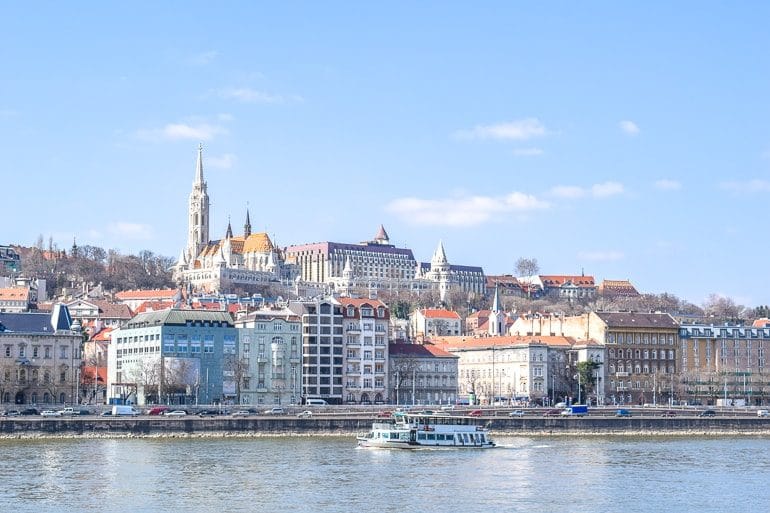
The Fisherman’s Bastion is another one of those super beautiful and famous landmarks that we just didn’t get the chance to check out.
It was probably named after the guild of fishermen who used to live in an area under the walls in Buda on the banks of the Danube.
Technically part of the Castle complex, the Bastion was originally built in 1895 as part of Hungary’s 1,000-year anniversary celebrations.
The Bastion was badly damaged in World War II and has since been rebuilt and restored more than once.
To visit, some viewing areas are free while others are paid entrance. You can find those breakdowns here.
Address: Budapest, Szentháromság tér, 1014 Hungary
House of Terror Museum
If you come to Budapest with a passion for learning about history (European political and social history), then the House of Terror Museum is for you.
Built in the former building of the “Hungarian Secret Police” and another ruling regime – the Arrow Cross Party – the museum is dedicated to showcasing the Fascist and Communist regimes in Hungary through parts of the 20th century.
The museum was first opened in 2002 so it’s pretty recent – and there is information offered in English and German. You can check out the official website for opening hours and admission fees.
Address: Budapest, Andrássy út 60, 1062 Hungary
Visit the Parliament Building
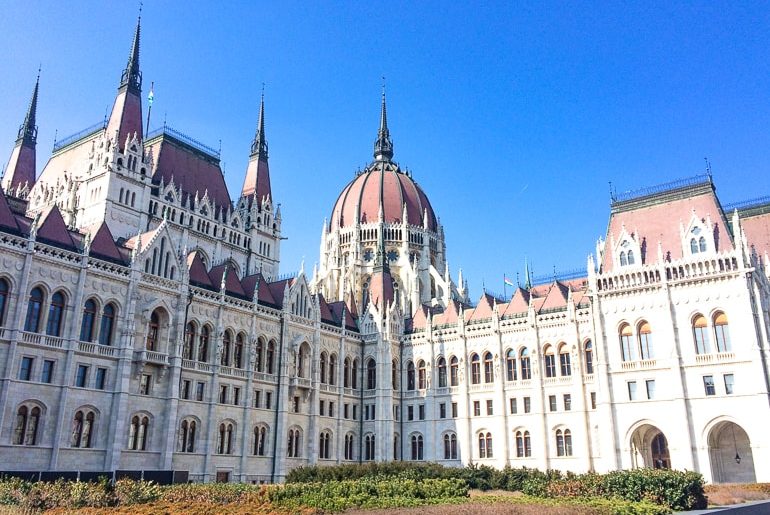
The Parliament Building in Budapest is stunning with a rich history. Built starting in 1885, the building was inaugurated for the 1000 year anniversary celebrations and actually completed in 1905.
The outcome was well worth the wait! The Gothic Revival style of the building makes it stand out on the banks of the Danube for all to see.
Fun Fact: During the Communist years, there was a red star placed atop the main dome. The star was removed in 1990 when Hungary broke from the USSR.
We walked around the outside because the weather was so nice and snapped lots of photos.
If you’d like a guided tour of the Parliament Building to see the Royal Jewels, the Royal Crown, and other pieces of Hungarian history – then check out a highly-rated “skip the line” tour of the Parliament that comes in many languages with a real live guide!
Address: Budapest, Kossuth Lajos tér 1-3, 1055 Hungary
Visit St. Stephen’s Basilica
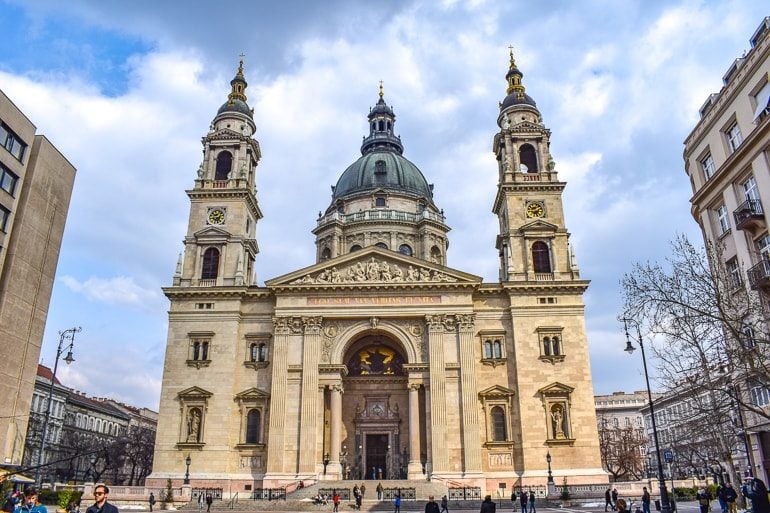
St. Stephen’s Basilica was built in 1905 and serves as an active place of worship for the Hungarian people.
Current building regulations in Budapest state that no building can be built taller than the high point of the Basilica.
Interestingly enough, the tallest point of the Hungarian Parliament stands at the exact same height.
You can go inside for free – but you’ll have to watch for when there is mass taking place. A small donation is encouraged, but not required.
If you want the amazing views, you can buy a ticket for a small fee and climb (or take a lift partially up) to the top of the dome to snap breathtaking photos of the surrounding city.
The Basilica also has live performances by a famous organist – and you can attend an organ performance concert in the Basilica if you’re interested.
The sound, the architecture and the ambience make this a highly recommended experience! Check out the Organ Performance at St. Stephen’s Basilica here.
Address: Budapest, Szent István tér 1, 1051 Hungary
See Heroes’ Square
Located in the northeast end of Pest on the edge of City Park, Heroes Square stands as the largest square in the city.
Funny enough, it was close to our Airbnb and we didn’t even get a chance to go and check it out!
The square was first built in 1896 to commemorate the 1,000 anniversary of Hungary (the Magyar tribes settling there).
As time went on, important political and historical figureheads were included – and you’ll even find the Tomb of the Unknown Soldier located here.
The central pillar has the statue of Archangel Gabriel and the seven chieftains of the original Magyar tribes.
We were told to check it out twice: once during the day, and once in the evening when it’s all lit up! The square is in City Park (Városliget) and connected to the end Andrássy Avenue which makes for a great stroll into the centre of Pest.
Address: Városliget (City Park)
Visit the Vajdahunyad Castle in City Park
Another attraction that is tucked away in City Park is Vajdahunyad Castle. This beautiful castle was first built of wood in the late 1800s but became so popular they rebuilt it out of stone!
The castle took inspiration from other historical places (castles) from around Hungary and what is now Romania. This explains why it looks like Dracula could have lived there!
Today, you can visit the castle. It houses the Museum of Hungarian Agriculture which is the largest agriculture museum in Europe.
In the wintertime, there is skating in the nearby pond once it freezes over. Imagine skating beside a romantic castle in Budapest! You can learn more at the official website.
While we’re here – there are more attractions in City Park like the Museum of Fine Arts and the Kunsthalle – another gallery. Be sure to check them out when you are up there, too!
Address: Városliget (City Park)
See the “Shoes on the Danube Bank” Memorial
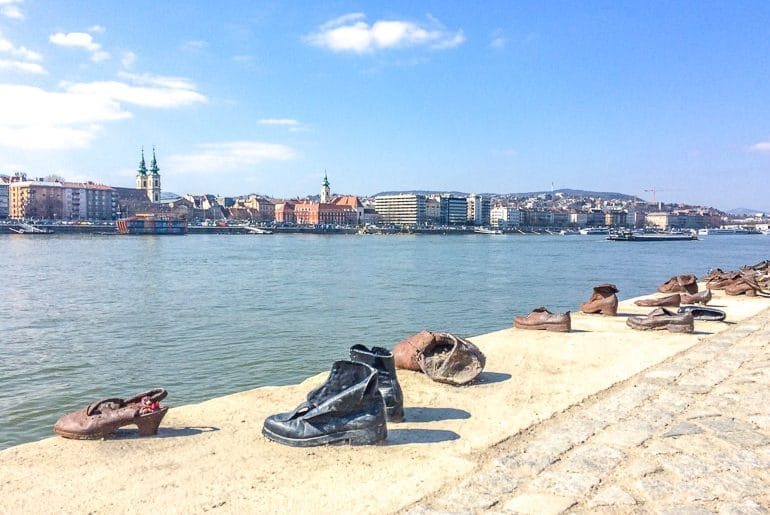
If the weather outside is nice, you can simply go for a long stroll down the riverbank of the Danube.
There are lots of sidewalks and pathways available for a stroll in either direction towards the other bridges that cross the river.
A main sight to check out is the “Shoes on the Danube Bank” memorial which is exactly like it sounds. Along the Danube, you’ll find a variety of iron shoes that are cemented into the sidewalk.
Created by sculptor Gyula Pauer, the shoes are meant to remember the 3,500 Hungarian civilians, many of them Jews, who were shot into the river by the ruling Arrow Cross militia (a Fascist arm of the German Nazi Party) between 1944 and 1945.
As the horror goes: Civilians were ushered to the edge of the Danube and ordered to take off their shoes before being shot.
The sixty pairs of shoes seen today are meant to represent the shoes left behind by their owners.
It’s an interesting and moving display that always has a small crowd around it. Some of the shoes often have flowers in them.
Because it’s important to remember and acknowledge history, we feel that the shoes on the Danube Bank shouldn’t be missed!
Address: Budapest, Id. Antall József rkp., 1054 Hungary
Attend a Performance at The Erkel Theatre
If you wanted to see a show at the grand old Opera House in Budapest – you will have to wait until 2020.
The historic building on Andrássy is under extensive renovations to get it up to speed with the tech needed to put on a top-notch performance in Europe these days.
This means that all performances (opera, ballet, etc) are held elsewhere – at the Erkel. The Erkel is a more modern venue that is close to Keleti Train Station.
Still, this hall gives spectators a show to remember. You can check the schedule to see if there is something going on while your visit here.
Address of the Erkel: Budapest, II. János Pál pápa tér 30, 1087 Hungary
Walk Across the Chain Bridge
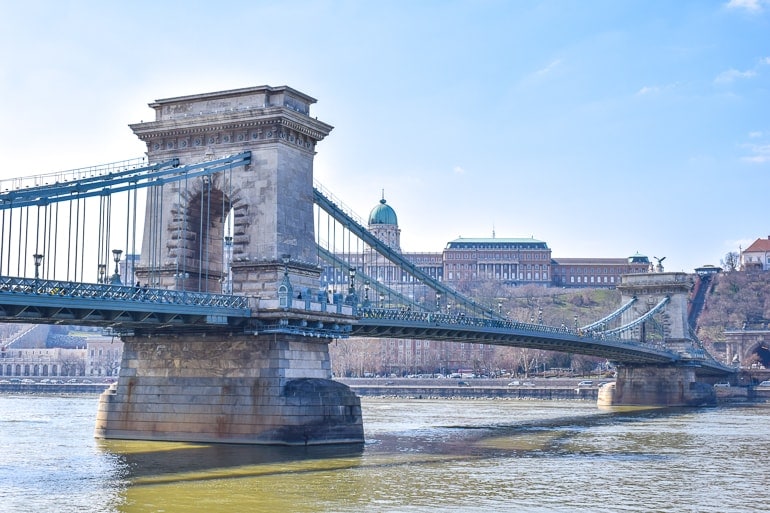
As one of the most iconic landmarks in Budapest (and bridge structures in all of Europe), you have to walk across the Chain Bridge.
Opened in 1849, this bridge has been connecting Buda and Pest for decades. The bridge crossing was actually completely demolished during World War II but was rebuilt in the years after.
It’s a very popular route to get to the Castle, so it’s not like you have to go out of your way to walk across the bridge.
You’ll get really great photographs – and be sure to say hello to the guardian lions that are mounted at each end of the bridge!
Visit The Dohány Street Synagogue
If you are wandering the 7th District, you might stumble upon something that catches your eye. This would be the Dohány Street Synagogue.
Originally built in the 1850s, the Synagogue is the largest synagogue in Europe and the second-largest in the world – housing 3,000 seats!
The building also houses the Hungarian Jewish Museum inside, as well. We have walked by countless times – and the building is gorgeous from the outside.
We know from friends and photos that the interior is even more stunning – so check it out and let us know what you think! You can learn more about prices and hours here.
Address: Budapest, Dohány u. 2, 1074 Hungary
Climb Gellért Hill
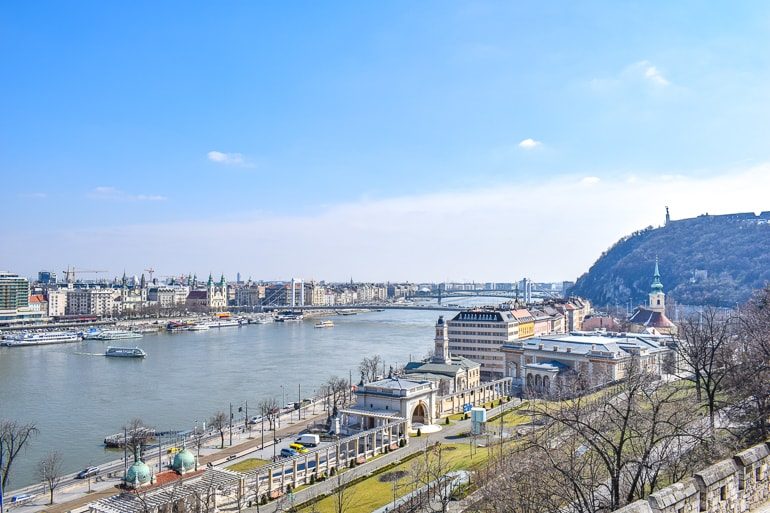
Aside from the amazing views of Budapest, Gellért Hill is famous because of its place in history.
The hill is named after Saint Gerard who was thrown to his death from the hill in the 11th century. Yeah – he was placed in a barrel and rolled down the hill during the Pagan rebellion.
During World War II, the Soviets used the hill as a strategic point when they retook the city. That’s why you’ll find the Liberty Statue – a monument that was erected by the Soviets to commemorate their victory in liberating Budapest.
Aside from that, the hill is home to the Citadel which was built in the 1800s has since been declared a UNESCO World Heritage Site. You can go inside if you want to see more of it.
If you want to see all that, you can expect a long walk up to the top, but there are lots of different paths that wind through the green parkland.
If you’re lucky, you might even see wildlife – apparently, there are lots of hedgehogs!
Gellért Hill is also home to the famous Gellért Hotel, and the Gellért Baths which are connected to the complex (we chatted about these above).
Helpful Reminder: If you stay at the Gellért Hotel, you get free entrance to the baths! Check out the prices for the Danubius Gellért Hotel.
Eat at the Central Market Hall
If you want an authentic Hungarian shopping experience, head to the Central Market Hall to see what shopping is like. This massive indoor complex has been a live market since the 19th century.
Located right at the foot of the Liberty Bridge – the one that runs to Gellért Hill, the restored marketplace has vendors selling fresh produce and meat as well as items that you can eat right on the spot.
There are also souvenirs if you are looking for that perfect Budapest trinket to take home.
Address: Budapest, Vámház krt. 1-3, 1093 Hungary
Go For A Stroll On Margaret Island
Located right in the middle of the Danube River to the northwest of the city centre is Margaret Island. This massive island is 2.5 kilometres long and full of things to do.
Besides walking the length for exercise and some tranquillity within the city, there are parks, live music, restaurants, hotels, and even baths to explore in the nice weather.
Bridges connect to the island at the north and south end so you don’t have to worry about which end you start or finish at!
Bonus: Explore the Budapest Caves
Given the unique geology of the Budapest region, you could also take your adventure underground for some caving.
Eric went crawling through the Budapest caves at the “Pál-völgyi-Mátyás-hegyi” cave system a few years back and had a great time. Here is the cave tour he did if you are interested.
It’s definitely not for everyone – especially if you have a fear of the dark or tight spaces – but the guides were great, supportive, and very safe!
Address: Budapest, Szépvölgyi út 162, 1025 Hungary
Things to Consider When Visiting Budapest
If you are thinking about exploring Budapest, here are a few things that you should know/consider before you plan your trip.
We thought it would be helpful to cover things like language, getting around, where to stay, and more!
General Information About Budapest
If you weren’t paying attention, Budapest is the capital city of Hungary. The city has changed hands a few times over the centuries but ultimately has been shaped by the Austro-Hungarian Empire.
While the city is one, there are two distinct sides (which were once divided: the hilly side of “Buda” and the flatter side of “Pest”. The river – the Danube – cuts through the city splitting the sides.
The language spoken is Hungarian but English can be found at many of the top attractions and restaurants in the city.
Just so you know, the money used is NOT the Euro but the Hungarian Forint which has very large denominations. Don’t be surprised when dinner is 11,000 Ft!
Best Time to Visit Budapest
If you’re heading to Budapest, the best time to visit is dependent on what activities you are looking to do.
Obviously, the summer months from June to August are hot and nice – but they can also be very busy.
Budapest can get quite cold in the winter – with December having more snow and precipitation while January and February are colder.
That said, there are loads of winter activities like the Budapest Christmas markets and ice skating in City Park!
We’d suggest travelling during the shoulder season – March to May or September to end of October.
These months are cooler but still nice and typically don’t have the crowds of the summertime. If you need help with packing, here’s our packing list for Europe!
Getting Around in Budapest
Since Budapest is more of a modern city, you don’t get those crazy cobblestone roads as you do in Edinburgh or Prague.
It’s a very walkable city on the Pest side but the Buda side can come with quite the elevation changes. We walked basically everywhere but we also took the metro a few times.
Budapest has a pretty good public transportation system with modern ticket machines that are easy to use. There are also options for “day passes” for visitors. They even made getting to and from the Airport simple with the 100e bus.
If you want to use public transportation, you can check out the different options for tickets/passes here.
Depending on how long you are in Budapest, you can get a travel card which is for just transportation or a “Budapest Card” which is both a transport pass and discounts on attractions for your length of visit.
Here’s a link to a 72-hour travel card and a link to a 72 hour Budapest Card. You can also buy these for 24, 48, or even 96 hours, too.
Practically speaking, Budapest can be a touristy city (in places) so if you wanted an easy way to get around you could also buy a hop-on hop-off sightseeing bus ticket and use it as a way to get between the top attractions in Budapest.
Where to Stay in Budapest
We’re not going to cover the topic in-depth here because we wrote a whole detailed guide (see above links). We once stayed close to the Budapest Keleti train station.
However, there are also lots of great districts to stay in with a variety of hostels and hotels to suit everyone’s budgets and needs.
As for hotels, check out Hotel Papillon which is located on the Buda side of Budapest just to the north of the Parliament building.
The other highly-rated hotel is Walk Inn Váci 78 located right in the heart of Pest. We actually walked by a few times and now that we’ve looked at the photos, Lisa wants to stay there next time we’re in the city!
If you’re looking for hostels, our post on the ultimate Europe itinerary talks about the Budapest party hostels.
One of them made our list of favourite hostels to stay at in Europe! Our post on 9 unique hostels in Europe mentions Maverick Lodge Hostel.
And there you have it – 21 of the top things to do in Budapest! Of course, this is not everything but there are definitely some “not-to-miss” items here.
Eric really liked going caving since it’s such a unique experience you don’t get in many other places.
That said, Budapest is full of amazing history and attractions that you will have no problem filling up your time in the city. Have a blast exploring Budapest – let us know what you get up to!
As always, Happy Hungarian Waddlin’,
-L&E
Related Articles
Also, if you are planning a trip to Budapest, here are a few more posts that you may find helpful:
- What To Do in Budapest in Three Days
- Our Favourite Coffee Shops in Budapest
- How to Spend One Day in Budapest
- Top Restaurants in Budapest (Told by a Foodie Blogger)
- The Best Areas to Stay in Budapest – Neighbourhoods & Hotels
Pin it for later!


